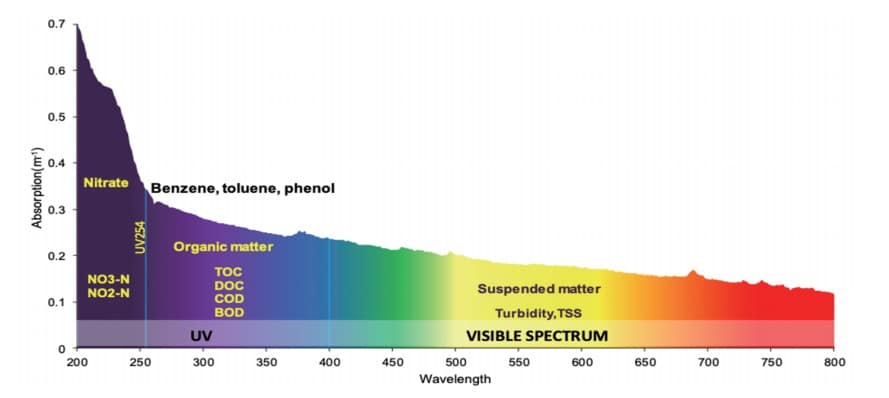Certain manufacturers offer single-wavelength sensors, while others, like UlikSensor, provide both multi-wavelength and full-spectrum sensors, which yield higher accuracy and more parameters. Uliksensor full spectrum sensors, for instance, scan 600 wavelengths of UV and visible light to determine the concentration of a desired parameter. These sensors measure absorbance at each wavelength to generate a “spectral footprint,” which is then calculated into a concentration value based on the programmed algorithms. Spectral measurements offer superior precision and accuracy than single-wavelength sensors because the absorption by a molecule occurs over a range of wavelengths rather than a single one. The extra wavelengths yield several advantages, such as more absorption data for each parameter, a range of wavelengths for turbidity correction, and the ability to detect various organic molecule forms.
UV Vis spectral sensors, which scan 600 wavelengths, span both UV and visible wavelengths from 200 to 800 nm. In comparison, UV spectral sensors scan 256 wavelengths ranging from 200 to 390 nm. This allows UV sensors to measure and differentiate between nitrate and nitrite. Nitrate and nitrite absorb mostly at the shorter UV wavelengths (<250nm), while organic molecules absorb most strongly at UV wavelengths between 250-350nm. Absorbance across 380 to 800 nm is from turbidity, which is measured and corrected with each measurement.
However, there are two single-wavelength sensors that use the absorbance of one wavelength to determine the concentration of a particular parameter. The UVT-254 sensor (or SAC-254) measures the transmission or absorbance (%) of light at the 254nm wavelength. This sensor is useful for trending organic concentration within drinking water and wastewater, as UV light at 254nm is absorbed by organic molecules. With the UVT-254 sensor, an accurate calibration and a second wavelength (550nm) measurement for turbidity correction can report a correlated value of COD, BOD, and TOC. The NOx sensor measures the sum of nitrate (NO3-N) and nitrite (NO2-N) using a single wavelength, which can be sufficient for monitoring nitrogen in some biological nutrient removal applications.
While single-wavelength sensors can provide useful data and trending, they are less accurate and repeatable than spectral sensors. With single-wavelength measurements and turbidity correction, these sensors may not detect certain organic molecules, cannot differentiate between nitrate and nitrite, and may not correct for turbidity as precisely.
Both single-wavelength and spectral sensors have their advantages, but which one is suitable for your application depends on your needs. Single-wavelength sensors can provide trending for organics or NOx at a moderate price, and some applications require their use, such as UVT-254 for UV disinfection. However, spectral sensors are calibrated to specific applications (influent, secondary treatment, effluent) and, because they scan 600 wavelengths, they provide higher accuracy, repeatability, and better correction for turbidity than single-wavelength sensors.

